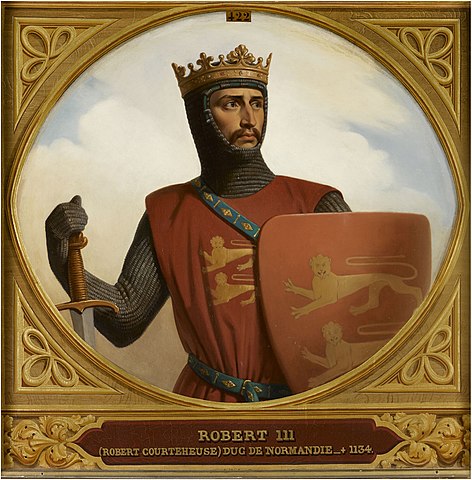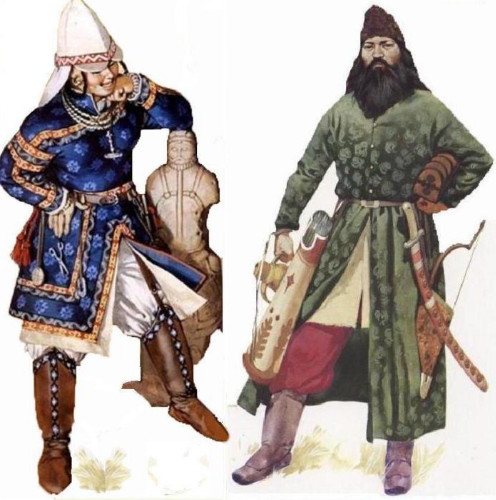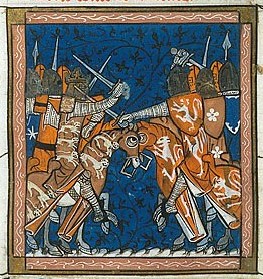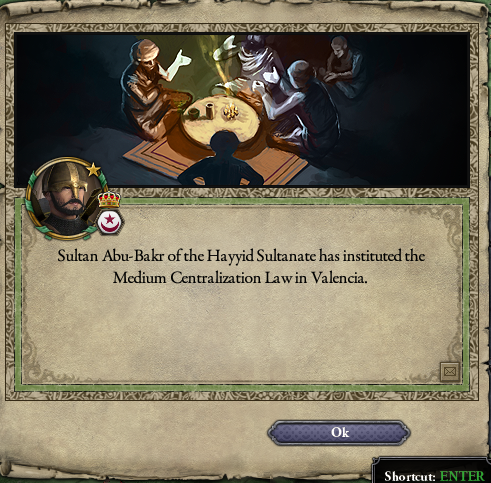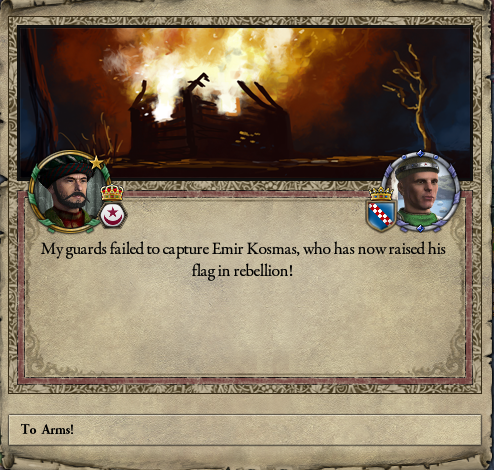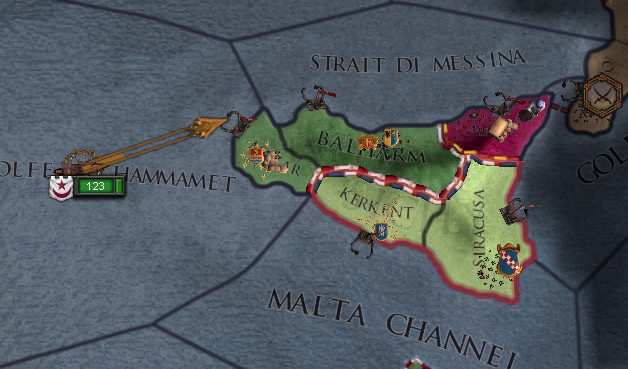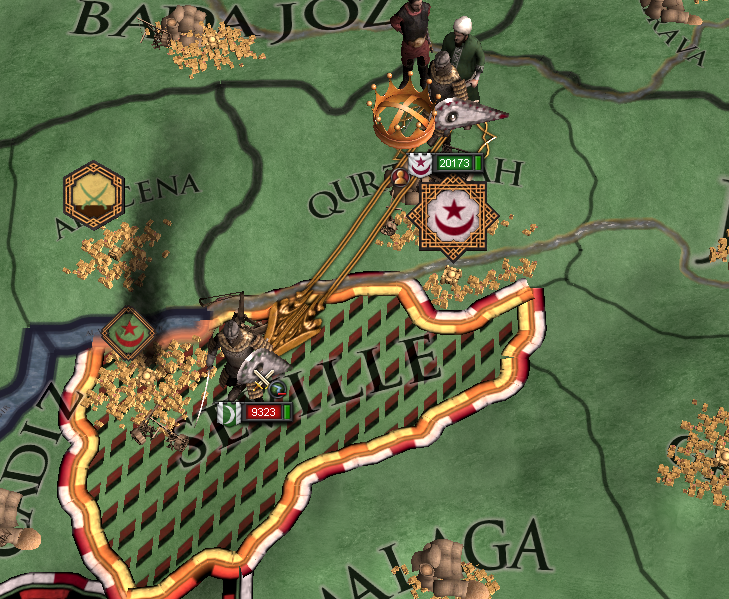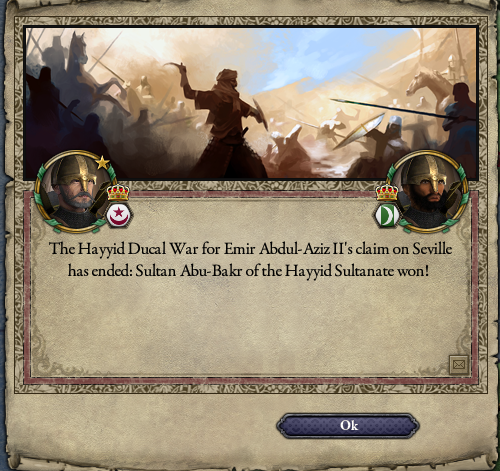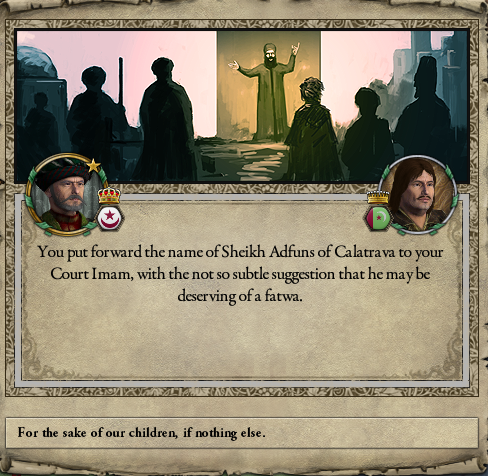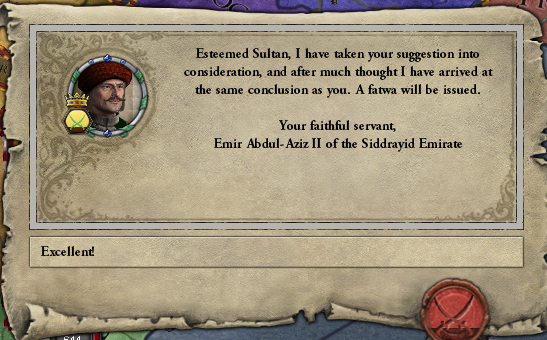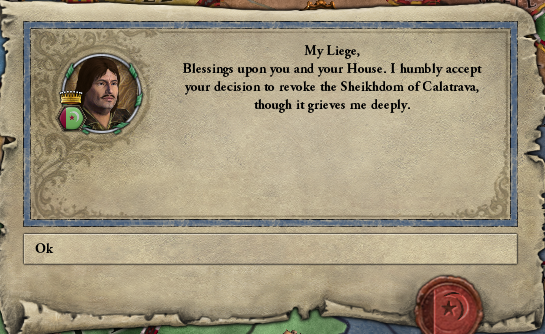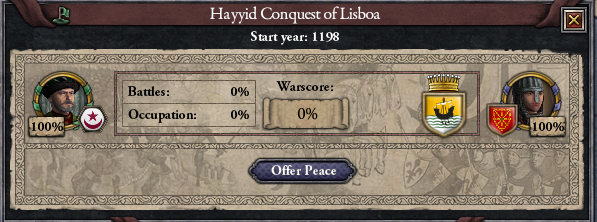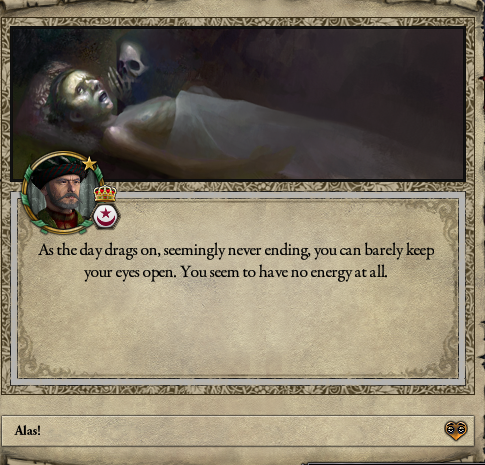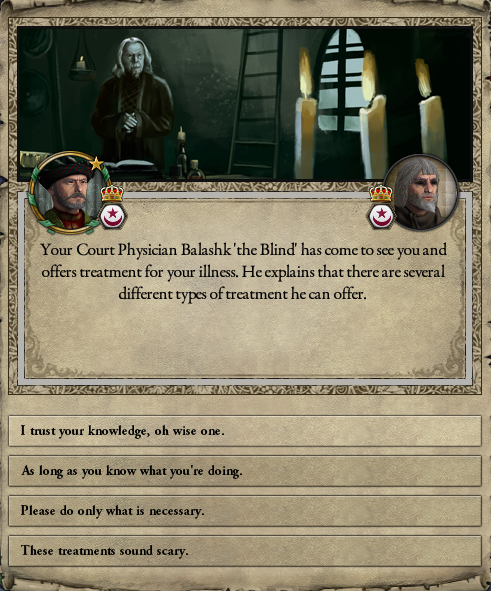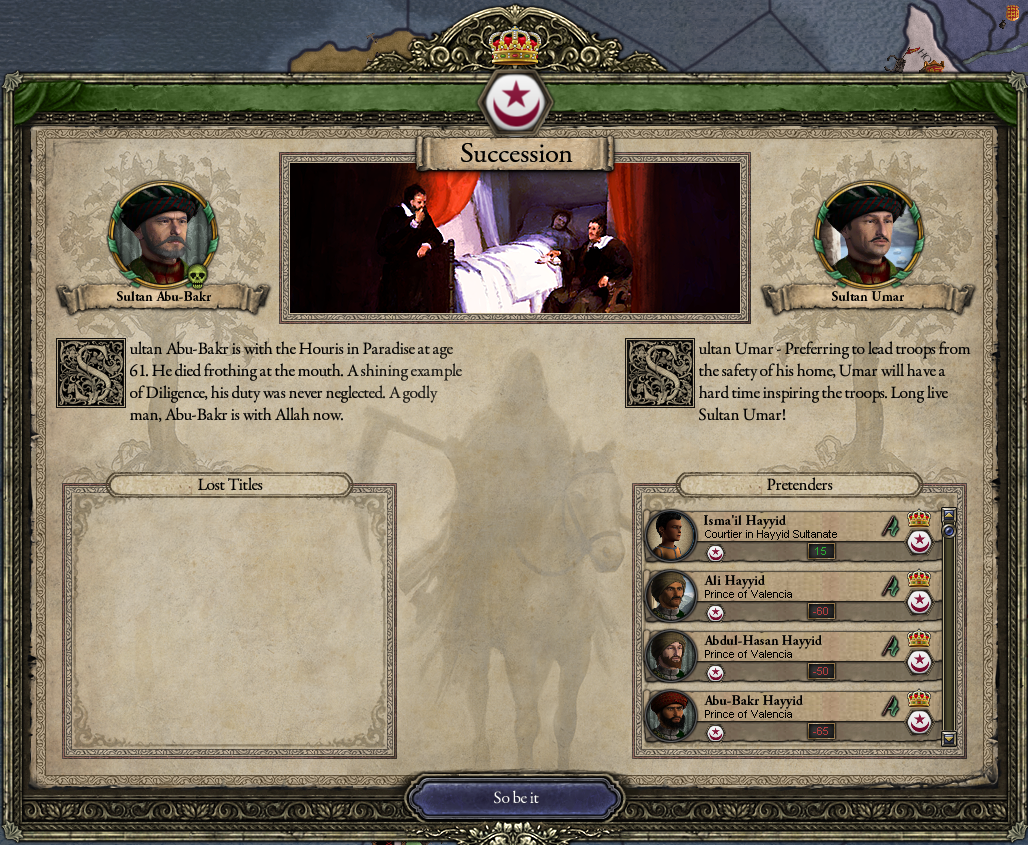Chapter X - To Claim and Conquer (1142-1156)
With a sense of stability now returning to the Hayyid realm, a new opportunity for conquest presents itself. Sultan Ali elects to provide the Sheikh of Cádiz the once in a lifetime opportunity to join his realm through vassalisation. The security of Hayyid rule would surely be worth the small amount of tax paid to the Sultan? Alas, the Gaditano didn’t seem to think the offer was anywhere near as appealing as Ali made out. Well, without the Sultan’s protection there would be no way to protect Cádiz from predatory neighbours...like the Hayyid Sultanate! The troops are mobilised and war declared.
Vastly outnumbered and with little hope of victory the Gaditano laid down their arms in May of the following year.
With Cádiz now joining the Hayyid realm, many of the smaller remaining independent Sheikhdoms in Iberia now elected to bend the knee peacefully rather than engage in a foolhardy war. The Sheikh of Mértola could see the example made of Cádiz very clearly and so joined the realm with little fuss.
Thus far much of Ali’s reign had been concerned with internal matters and reforming the Sultanate so that it may experience greater stability in the years to come. Whilst these reforms may have earned Ali praise from later historians, among his contemporaries Ali was incomparable with the likes of the great Sultan Mundir. If he was to make a name for himself here and now he would need to test his might against the
Kafir. Much of the western coast of Iberia had come under the rulership of the King of Galicia, but now it was the time for the Hayyid’s to liberate their Muslim brethren. War was declared over the lands of the Algarve.
Combined, the forces of Sultan Ali and his allies greatly outmatched the Galicians and their Aragonese allies. The Battles of Beja and Mértola proved to be over before they had begun, whilst the remaining Christian force was wiped out at Egitanea handing the Hayyids victory.
Dissatisfied with the lack of a challenge posed by the Galicians and confident of their newfound power, Ali and his allies set their sights on much bigger fish. The time had come for the Hayyids to liberate Castellon from French hands. The opportunity was doubly ripe given the French were currently at war with the English (where have we seen this before?). War was declared in 1145.

The province itself was bereft of troops. All French forces were off fighting in the north. Ali and his camp set in for a siege. But only a few days into it, important news reached the Sultan. Caliph Murad had called for a jihad to liberate Egypt from the infidel and it was the duty of all righteous Muslim’s to take up arms! This was it. This was the chance Ali had been waiting for. A chance to prove himself and crush the Crusader states. But he was already at war with the French. There was no way he could split his force and win on both fronts. He had to mop up the French campaign as quickly as possible before committing to Egypt. With his plan in place, Sultan Ali wrote personally to Caliph Murad promising to join the struggle once his current war had concluded.

After besieging the province French forces began to march into Iberia. Divided into three armies of near equal size, one in the north and two in the south, the combined Hayyid force was able to hit each individually. The southern armies would fall first as it posed a far greater threat to Córdoba and the Sultanate’s interior. At Valencia the first of three French forces would fall, quickly followed by the French army besieging Granada.
The final French army parked in the north to defend French Valladolid would be hit the following year and quickly defeated. With that Ali was now free to fulfil his promise to the Caliph of joining the jihad to free Egypt.
Yet, as Ali and his armies prepared for the long march across North Africa, horrid news came through. The Jihad was off! How could this happen in such a short time? Why did the Sunni faithful give up so easily? It appeared as though the Seljuk army was caught off guard once it set foot in Egypt. With the Sinai left undefended the Caliph’s army marched directly into the heart of the Crusader State and was ambushed by the infidels after crossing the Nile. The resultant battle was calamitous for the war effort with the Caliph and many other Seljuk generals being captured in the aftermath. With that, the war was brought to a rather unfortunate and underwhelming end.

And with that bad news came something a little more foreboding. Whispers were brewing of a warlord in the far-east who had united the horsemen of Mongolia and proclaimed that he would conquer all lands of the great steppe and beyond. Whilst most within Ali’s court dismissed these murmurs as the musings of a mad-man or overconfident ruler; some harboured doubts at the back of their mind. Could this Khan truly be a threat to the entire world?

Since the rule of Hakam I and the expansion of the realm, numerous advances had been made in the administration, enabling much faster communication and travel between the provinces. Infrastructure such as roads and the creation of a mailing system now allowed the Sultan’s reach to be felt across the realm. It would now be much easier and faster for the Sultan to keep in touch with his vassals and for his armies and enforcers to move around the realm. The Hayyid Sultanate was very slowly but surely becoming more centralised and administratively efficient.

Whilst the Hayyid realm had garnered much of its wealth through trade, of late a number of Christian merchant republics had begun to establish trading posts along the shores of Ali’s realm. In most cases, the agreements to build these ports were signed with local rulers and not the Sultan himself. With the administration of the realm improving Sultan Ali believed it was only right that the crown control the realm’s outward trading policy. Recently Ali’s relationship with the Spoleto family of the Republic of Genoa had soured considerably. Patrician Giolio had come to the Hayyid court in an attempt to sign a preferential trading agreement which whilst benefiting his family, cheated the Sultan out of his rightful trading dues and did nothing about goods imported from Genoa. The Patrician would now learn what it would mean to try and cheat the Sultan.

And with an angry mob roused against the vile Spoleto family the trading post at Malaga was burned to the ground. Giolio will think twice before trying to cheat the Hayyid’s again.
News also reached Sultan Ali that a notable Andalusian scientist Ibn al-Baitar had returned from his journeys. Having documented and collected a large number of previously unknown plants and remedies on his journeys the man has caused quite a stir among the upper-echelons of Hayyid society. With Ibn al-Baitar the talk of the town Sultan Ali decided to personally pay the man a visit.
Having perused his collection of plants and the new medicines found on his journey through North Africa, Arabia, and Anatolia. Sultan Ali was so impressed that he demanded al-Baitar join him at court. But the Sultan also requested al-Baitar’s plant collections and other scientific discoveries be made freely available so that learned men may study botany and medicine. Though sceptical of the proposal at first Ibn al-Baitar eventually relented after much persuasion and quite a lot of patronage. Sultan Ali had his own Court Botanist. Though he didn’t know it at the time, Sultan Ali had just laid the foundations for something far greater...

Despite Ali’s administrative victories, the Sultan still believed that his military record remained insufficient. The victories against Galicia and France had been relatively easy for a number of reasons. The failure of the Jihad continued to hang over the Sultan like a black storm cloud. One great victory over the infidels, not some one-sided battle, a true clash of titans! That was all he needed. One to be remembered. That was when he knew what he must do. Ali would be the Sultan who crushed the Kingdom of Aragon and expanded the Hayyid realm to the Pyrenees. The declaration of war was sent to King Juan and the troops were mustered.
Aragon was not without its allies. Though the other Spanish Kingdoms looked to sit this one out and lick their wounds, the Knights Templar announced their intention to stand with Aragon against the Hayyids. More worryingly Gauthier, King of France also threw himself behind the Christian defence. If it was a fight Ali wanted, he would certainly get one.
The 17,000 strong Hayyid army quickly pounced on the Aragonese before they could prepare. Around 4,000 troops were sent into retreat from Soria, freeing the path to the capital of Zaragoza.
With the numbers against the Hayyids it was necessary for Ali’s armies to keep their enemies forces weak and divided. The decision was taken for the besieging army at Zaragoza to abandon its position to hit the Templars at Castellon. A powerful Aragonese army of around 12,000 was approaching from the west and both forces could not be allowed to combine.
Fortunately, the Aragonese planted their forces in Zaragoza in an attempt to retake the capital. The Hayyids swept around the Sistema Ibérico to hit the remaining Templar army; but not before joining up with their Maghreb allies to make an army of nearly 20,000 strong. Surely nothing could stop the Hayyid onslaught that was to come.
But hearing of this new Hayyid army, the Aragonese, reinforced by the French, moved to defend their retaken capital. Both sides clashed near the mountains of Gormaz. Reinforced by their strong defensive position the combined Aragonese-French force held out day after day, night after night. For over a month the battle raged.
Eventually, the strain of battle proved too much for the Christians who pulled out on July 23rd, but they had inflicted a heavy wound on the Hayyids. Ali’s army had lost 6,000 men relative to the 4,000 losses for the infidel. Worse, the Castilians had now joined the war effort bolstering the size of the opposing armies.
With numbers dwindling on the Hayyid side, and the Christians now besieging Castellon, Sultan Ali decides to invest in a mercenary army in hopes of crushing the opposition. 10,000 Malian slave warriors known as the Ton-Tigi were contracted to aid the Sultan’s war effort at a great financial cost to the realm.
Before the mercenaries could reinforce the Hayyid army though the Templars were back for revenge, catching Ali’s forces off guard whilst they besieged Zaragoza once more. Outnumbered and outmatched there was only one way this battle was ended.
Yet against all odds, the Hayyids held out. No matter what the Templars threw at Ali’s forces they could not break the will or the steel of the Sunni faithful. After two weeks of constant fighting, the Templars withdrew. This day would be long remembered in the annals of history.
In the aftermath of the battle of Veruela, the remaining Hayyid forces stormed Castellon to take out the Castilians.
Not only were the Spaniards driven from the Hayyid lands, their King, Fernando ‘Son of Satan’ was captured by the army and brought to Sultan Ali’s dungeon. A prized prisoner if ever there was one. This would make an excellent bargaining chip for the negotiations at war’s end.
With victory in sight, the Hayyids marched north once more in an attempt to lift what must have been the fourth siege of Zaragoza that this war had seen. The similarly numerous Templar army was just another foe to be easily brushed aside by Ali’s invincible army.
But for the Sultan himself, invincibility was not the first word on his own mind. That word would be mortality. His mortality. For some time now Sultan Ali had been suffering from pain and swelling within his joints. He had kept this to himself for many years in an effort to preserve an image of an austere, strong rule; but now the pain was far too much. Something was clearly very, very wrong. After consulting Court Physician Bilal the diagnosis was clear. Gout.
Bilal believed the Sultan’s condition was in a very late stage and that if not operated on immediately, it could be fatal. Reluctantly, Sultan Ali agreed to the treatment, though by the time he reached the operating table, he probably wished he hadn’t.
“Removing the afflicted appendage is the only way my lord. Trust me, I know what i’m doing,” were the last words Ali heard before the calming potion got to work.
Sultan Ali never awoke from the operating table. Official reports suggested that the Sultan had died from ‘complications with gout’. Though more than a few around the court suggested it was Emir Bilal who was responsible. Though his administrative and educational reforms would live on, garnering much praise from later historians and statesmen; he never quite fulfilled that one desire for a great victory memorable for all time. He was so close, but alas it was snatched away just when it seemed most assured.
































































